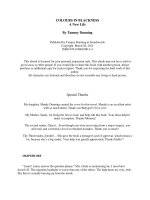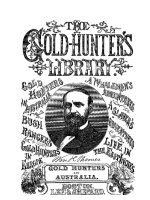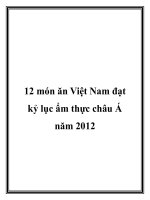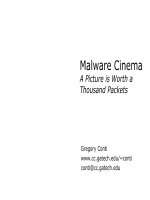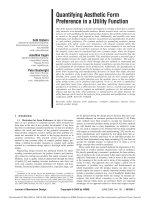ZIM A BASEBALL LIFE pot
Bạn đang xem bản rút gọn của tài liệu. Xem và tải ngay bản đầy đủ của tài liệu tại đây (2.04 MB, 474 trang )
ZIM
ZIM
AB
ASEBALL LIFE
Don Zimmer
with Bill Madden
Copyright © 2001 by Don Zimmer and Bill Madden
This edition published by Barnes & Noble Digital, by
arrangement with Total Sports Publishing, Inc.
All rights reserved. No part of this book may be used or
reproduced in any manner whatsoever without the written
permission of the Publisher.
2001 Barnes & Noble Digital
ISBN 1-4014-0114-7
This book is for the hundreds and hundreds of friends I've
made in baseball, but most importantly for my best friend,
Soot Bauerle Zimmer. My baseball friends have said she is a
saint, and that's an understatement for having to put up
with me for half a century. They say I've had a baseball life.
This woman is my life.
—
D.Z.
For Lil, my No. 1 fan, on whom baseball is no longer lost.
—
C.W. M.
C ONTENTS
Prologue ix
Foreword xv
Acknowledgments xvii
1 Who Am I and How Did I Get Here? 1
2 Dodger Blue 20
3 Cubs to Casey to Home 75
4 From Washington Senator to Foreign Correspondent 98
5 Back to the Bushes 122
6 No Day at the Beach 148
7 Banned in Boston 166
8 A Real Texas Gusher 223
9 Billybrawl and Two Reunions 252
10 My Kind of Town 292
11 A Red Sox Redux and a "Rockie" Retirement 330
12 I'm a Yankee Doodle Dandy 360
Photographs 441
About the Author 458
P ROLOGUE
It had taken him nearly six weeks to make the call.
After contemplating the pain in his knee and the
aftereffects of a severe case of the flu (brought on by
a half-dozen cross-country trips at the end of the sea-
son), he decided he would come back for his 53rd
year in baseball. On this day, Don Zimmer found
himself strolling among the images of the game's
immortals in the Hall of Fame. Outside, the grounds
were covered with a fresh coating of snow, tempera-
tures hovering in the 20s, and all those summers in
Brooklyn, Los Angeles, Cincinnati, Washington,
Tokyo, San Diego, Boston, Texas, Chicago, Denver,
and the Bronx never seemed so far away. It was, as
Zimmer observed, about the unlikeliest place he
could ever expect to be at any time in his life, let
alone three weeks before Christmas and six weeks
before his 70th birthday.
"I still can't figure out why you want a .235 hitter
like me here," he said to Hall of Fame President Dale
Petroskey, who merely smiled and replied, "Because
you're as much a part of this game as any of the peo-
ple enshrined here."
It seems they wanted his uniform to be displayed as
part of a special Subway Series exhibit
—
a request
Zimmer could only find amusing. "Imagine," he said,
"all these guys on these great Yankee teams of Joe
Torre, and I'm the first one going to the Hall of Fame!"
ix
x ZIM
As he would soon discover, however, they wanted
much more than just his uniform. They wanted the
man and, most especially, his memories.
To the baby boomer generation, he was our
unlikely baseball tour guide
—
this squat, bald, imp-
ish man with a face like lumpy oatmeal; the self-made
journeyman with whom we could all so easily identify.
It was his journey that took us from the innocence of
our gum-card-collecting youth to our $150 seats at
the World Series five decades later. And all the while,
he could maintain the pixyish smile of a man who
knew that the real meaning of the baseball life was
fun.
As Petroskey and the Hall of Fame historians
would later attest, it was Zimmer, and Zimmer alone,
who could provide that bridge
—
uninterrupted
—
from the infancy of integrated baseball to the era of
the $250 million contract. Now it was a game in
which Hispanics made up nearly 25 percent of its
population. Only Zimmer was there when a young
Puerto Rican outfielder named Roberto Clemente
was being squirreled away in the Brooklyn Dodger
farm system, and when another Puerto Rican out-
fielder, Bernie Williams, would haul in an $87.5 mil-
lion contract from the New York Yankees. And when
a thirty-something refugee pitcher they called "El
Duque" joined the Yankees in 1998 after reportedly
fleeing Castro's Cuba on a rickety boat, Zimmer had
been the only one who could speak from experience
to him of having played on those same Havana ball-
fields before the revolutionists arrived.
Yes, as Petroskey knew, only Zimmer could tell
them what it was like to be both Jackie Robinson's
teammate and Derek Jeter's mentor.
Like Forrest Gump, he was right there, in the mid-
dle of it all, as baseball evolved from a sleepy-time,
all-white, mom-and-pop pastime whose boundaries
did not extend farther west than the Mississippi
River, to a global, corporate colossus.
You could only wonder how much of this was sift-
ing through his mind as he strolled through the
great hall of plaques in the heart of the museum. So
many former teammates
—
Robinson, Reese, Snider,
Campanella, Koufax, Drysdale. The fiercely con-
tested opponents of youth who became kindred
friends
—
Berra, Musial, Ashburn, and Roberts.
"Robin Roberts lives near me in the Tampa area,"
Zimmer said, grinning, "and I was at a breakfast with
him the day before I came up here. I couldn't resist
telling him I was going to the Hall of Fame. He told
me to say hello to his plaque. So that's what I'm
doing."
"Ashburn, now there was a dandy. We were team-
mates twice, on a bad Cubs team and an even worse
Mets team. Oh, the fun I had with him, especially
years later when he was a broadcaster with the
Phillies and I was either coaching or managing the
Cubs. He'd always have me on his pregame show. We
Prologue xi
xii ZIM
told our stories and we'd both be laughing so hard
we could barely get through the show."
But when he got to Pee Wee Reese's plaque, he
paused, his face stiffening. His clear blue eyes began
to water and for a solemn moment Zimmer was
unable to contain his emotion.
"Captain," he said softly. "God, how I miss him."
Not far away from Reese's plaque were the ones of
Snider, Campy, and Robinson.
"I hope I live to see the day when Gil Hodges has a
plaque here too," Zimmer said. "I don't know what
the criteria are, but in my mind if Gil Hodges isn't a
Hall of Famer, I don't know who is. There was a man."
He moved on, past the cubicle that contained the
great black stars of the '50s and '60s
—
Hank Aaron,
Willie Mays, and Frank Robinson.
"I only played with Frank," he said. "Fiercest com-
petitor you could ever find. Aaron was just one great
ballplayer. People only talk about his home runs. He
doesn't get the credit he deserves as an outfielder. He
could throw and field with Clemente or Kaline. Mays,
what can you say? Wasn't no way he couldn't beat
you. He was simply the best there ever was. That's just
my opinion."
He had stories about all of them, of course.
Stories he would gladly retell for the Hall archivists.
Hell, he'd been telling them for seven decades, to all
the new generations of baseball players if they
wanted to hear them. They did.
"What was Pee Wee Reese like?" Jeter would ask
him, echoing the question of yesteryear, "What did
you do in the war, Daddy?"
And Zimmer would reply in mock disdain, "You
don't want to know. Do you think I'm gonna tell you
he wasn't as good as you?"
And then he would proceed to regale the young
Yankee shortstop with his Brooklyn war stories. He
would tell him how Reese was a totally different
shortstop than Jeter in that he didn't have the size,
the speed, or the power. What he had was indefin-
able leadership. It was a different game back then.
Shortstops weren't expected to hit home runs.
Pitchers weren't afraid to pitch inside, and they fin-
ished what they started. Guys played hurt for fear of
losing their jobs. Worked offseasons, too, to make
ends meet.
"I don't begrudge anything today's players get,"
Zimmer said. "It astounds me that owners would
pay as much for one player as they have for the
entire ballclub. I can't relate to that, but I accept it
as how the game has changed. One way it hasn't
changed, though, is that money doesn't necessarily
buy championships. I live in Tampa and I watched
the team there spend a ton of money before the
2000 season. Then they went out and won 69
games. You spend all that money, you expect to
win. Maybe that's what makes Steinbrenner differ-
ent. He gets accused of spending a lot of money
Prologue xiii
xiv ZIM
and he does. But he wins. Must be because he
spends it on the right players."
Zimmer knew from the money too. Any one of his
individual World Series shares from the Yankee
championships of '96, '98, '99, and 2000 was more
than he earned his entire playing career. But despite
the cold, corporate, money-driven enterprise base-
ball has become, the fun, he insisted, still hasn't gone
out of it for him.
"Maybe," he said, "it might have, had I not been
around this Yankee team with Joe Torre these last five
years. There's nothing more fun than winning, and
these guys have been special."
So after coming to this sacred baseball place at the
behest of its keepers, he was more assured than ever
that coming back for another season was the right
thing for him to do. He remained Joe Torre's indis-
pensable sidekick and the last link to Pee Wee
Reese's Brooklyn. And he would remain true to both.
B
ILL MADDEN
COOPERSTOWN, N.Y.
D
ECEMBER 2000
F OREWORD
Quite simply, Don Zimmer has a feel for the game
like nobody else. He sits next to me in the dugout for
every game, offering sound advice and entertaining
us with incredible stories.
Zim has managed four different teams (San
Diego, Boston, Texas, and the Chicago Cubs). He has
also coached for the Yankees two other times before
he joined the team in 1996, so I knew his experience
plus his time in New York would be valuable for me.
He's old school, yet to watch him communicate with
the young players says a lot about his love for the
game and the way it's played.
Zim's experience was invaluable on our way to
four World Series championships. During a game, it's
"we can steal on this guy" or "let's hit and run here."
We would agree and disagree, but we never stopped
communicating to find a way to win. Zim and I make
a good combo
—
sort of like fire and ice. I guess I
don't have to tell you who's who.
Passion is a word that describes my bench coach
very well. He's got that fire in his belly. I thought I was
going to lose Zim to retirement in 1999 when, during
spring training, he had knee surgery and I was diag-
nosed with prostate cancer. I asked George
Steinbrenner if he would be okay with Zim taking
over during my absence. The workload of managing,
a bad knee, and the Yankees
—
with all the pressure to
xv
xvi ZIM
win
—
took its toll. At first, Zim (out of respect) tried
to handle the team in the same manner as I would. I
told him to just be himself, but he felt very responsi-
ble, and the fire burned bright and intense.
I've managed for more than 15 years, and hired
friends to be coaches. In Zim's case, I hired a coach
who has become one of my closest friends. Picking
Zim as my bench coach may have been the best deci-
sion I have ever made. I check with him for approval
on everything except what wine to order at dinner.
Although I must say, he's come a long way. To slip in
beside Don Zimmer in the dugout, you would under-
stand why I've come to love this man. Four World
Series in five years
—
I'd say we're a pretty good daily
double. Also, the friendship that my wife Ali and I
share with both Don and Soot is terrific.
Zim: A Baseball Life is a warm, funny, sentimental
journey through seven decades of baseball. Zim has
seen it all, and now he tells it all as our personal his-
torian of the game over the last half century. I've
been so fortunate to be the beneficiary of all this
knowledge sitting right next to me. Now, in the pages
that follow, everyone else will find out exactly what I
mean.
J
OE TORRE
DECEMBER 2000
A CKNOWLEDGMENTS
The author would like to acknowledge and thank the
following people for their contributions to this book:
Soot Zimmer, for having both the foresight and
the tireless devotion to compile the two dozen scrap-
books and all the priceless photographs of her hus-
band's career which helped provide the basis for this
book.
Rick Cerrone, Arthur Richman, Jason Zillo, Billy
O'Sullivan, Matt McKendry, and Rikki Dileo of the
New York Yankees public relations department for
researching background information on Don
Zimmer's coaching career with the Yankees.
Josh Weintraub, segment producer for The Late
Show with David Letterman, for providing additional
anecdotal material obtained from Mr. Zimmer from
his appearances on the program.
Art Berke, a cherished friend who provided the
author the vast resources of Sports Illustrated, which
were invaluable in filling in details of Mr. Zimmer's life.
Moss Klein, Marty Appel, and Bob Raissman for
assisting in the research for this book.
Jeff Idelson and the Baseball Hall of Fame for the
hospitality they showed Mr. Zimmer and their assis-
tance in other research for this book.
David Fisher and Tom Connor, who believed so
deeply in this project and provided the relentless
encouragement to see it to fruition.
xvii
xviii ZIM
RLR Associates Ltd., particularly Jonathan
Diamond and Jennifer Unter, for making it happen.
Jed Thorn, for his capable line editing of this
book.
And lastly, Robert Wilson, a writer's editor, who
was a delight to work with. To quote Bogie's "Rick" to
Claude Rains' Captain Renault: "This could be the
beginning of a beautiful friendship."
1
Who Am I
and How Did
I Get Here?
1
I
thought of calling this book "Confessions of a .235
Lifetime Hitter," if only because my own grandchil-
dren have told me that the thing I'll be most remem-
bered for after 52 years in baseball is wearing an army
helmet in the dugout. Not for being a central figure in
one of the most brilliant managing moves in World
Series history, or for being one of the four $125,000
"premium" expansion players selected by the original
Mets in 1961, or even for managing two of baseball's
most storied franchises, the Boston Red Sox and
Chicago Cubs, in two of their most exciting seasons.
Nope, my grandkids tell me, that army helmet
—
which a national TV audience of 30 million people
saw me wearing in the Yankee dugout the night after
I got beaned in the head by a foul ball
—.
has forever
given me my special niche in baseball history.
I suppose that's only appropriate since the most
defining moments of my career have involved my
2 ZIM
head. In this latest and hopefully last one, it was the
fifth inning of the first game of the 1999 Division
Series between the Yankees and Texas Rangers. I was
sitting next to Joe Torre in the Yankee dugout in my
capacity as bench coach. Chuck Knoblauch, the
Yankees' leadoff man, was at the plate and he took a
funny swing at the pitch. I was half-looking out on
the field and half-watching Knoblauch and I didn't
see the ball until it was about two feet from my face. I
ducked my head and
—
smack!
—
I felt the ball hit me
on the side of my face. The next thing I knew I was
laying on the floor of the dugout, numb and woozy.
Then I saw blood and I got panicked. I yelled, "Get
this jacket off!"
They cut the jacket off me, carried me back into
the clubhouse and laid me on the trainer's table. I
was bleeding like a hog and didn't really know how
badly I was hurt. I knew I had been whacked in the
head but I didn't know where. That's what scared
me, knowing all the things that have happened to
my head.
As I lay there, I looked up and Yogi Berra and
George Steinbrenner were standing over me. It was
then that they told me the ball had hit me between
the neck and ear and had nicked the ear which
accounted for all the blood. George was especially
concerned and I heard him say they're going to have
to put a Plexiglass shield in front of the dugout
"because we can't have guys getting hurt like this."
They told me my wife, Jean, who I have always
affectionately called Soot, was out in the hallway,
and they led her into the clubhouse. I told her,
"Have someone take you back to your seat in the
stands, grab yourself a hotdog and enjoy the rest of
the game."
After she left, all I could think was, This would have
been a helluva way to end my career in baseball, especially
since this was the way it all started.
I grew up in Cincinnati, Ohio, and attended
Western Hills High School. My coach there, Paul
Nohr, was one of the greatest high school baseball
coaches ever. Nearly a dozen of his players, including
Pete Rose, Russ Nixon, Clyde Vollmer, Herman
Wehmeier, Ed Brinkman, and Art Mahaffey, went on
to the big leagues, and four of them
—
Rose, Nixon,
Jim Frey, and myself
—
all managed in the big
leagues. That's quite a legacy.
The summer before my senior year at Western
Hills, my American Legion team won the national
championship. The finals were held at Gilmore
Stadium in Los Angeles and we got to meet Babe
Ruth, who was at the game doing some promotional
work for American Legion baseball. Ruth gave a
speech after the final game
—
I'll never forget how
hoarse his voice was; he died a year later
—
and they
finally had to quiet the crowd down after about two
or three minutes so he could talk. He said he had
traveled all over the country watching American
Who Am I and How Did I Get Here? 3
4 ZIM
Legion baseball and the best team won. You can
imagine how that made us all feel. Then he signed a
ball for every one of us.
When we returned in triumph to Cincinnati, it
seemed like the whole town came out to the railroad
station to greet us. I lived on a dead-end street with
no traffic and we played ball there just about every
day. That summer, the ball we used was the one Ruth
signed for me. What did I know? We played with it
until we knocked the cover off it and then we put
black tape all over it. The last time I saw it, it was in
some sewer. Only a few years ago did I realize Babe
Ruth signed balls are worth anywhere from
$5,000–$10,000 in good shape.
As a reward for winning the championship, the
townspeople gave us a trip to New York and tickets
for the first two games of the 1947 World Series
between the Yankees and Dodgers.
I'll never forget that first day I set foot inside
Yankee Stadium and saw Jackie Robinson at first base
for the Dodgers. I think of that every time I walk into
Yankee Stadium. That was Jackie's rookie season, and
little did I know a few years later I'd be calling him a
teammate and, even more importantly, a friend.
During my senior year, in which I made all-Ohio
as quarterback for our football team and played
shortstop on the baseball team, I was offered numer-
ous scholarships to play both sports in college. I got
invited along with one of my best friends, Glenn
Sample (who was a tough lineman), to fly down to
the University of Kentucky for the weekend where
the legendary coach, Bear Bryant, had invited us. I
had never been in an airplane. Sample was planning
to go to college. I wasn't, but for a chance to get my
first plane ride, I made the trip with him. I roomed
with Babe Parilli, one of the all-time great quarter-
backs who went from Kentucky to a long career in
the pros. They had us throw passes and do some run-
ning in our T-shirts and shorts, and afterward Bryant
offered us full four-year scholarships.
I told him I was only interested in playing baseball,
and he understood. Years later, when I was managing
Knoxville in the Southern Association, Bryant's son
was the general manager of the Birmingham team in
the league. On our first trip to Birmingham, the visit-
ing clubhouse man came to me and said, "There's a
guy outside with a hat who wants to see you." It was
Bryant. A few years after that, he came to visit me
again in Boston when I was managing the Red Sox
and one of his former 'Bama quarterbacks, Butch
Hobson, was my third baseman.
I often thought about how funny it was to become
friends with Bryant, even though I never played for
him. I just wanted to play baseball and the sooner I
got my career underway the better. Naturally, my first
preference was to play for my hometown team, the
Reds, and they kept telling me how much they
wanted me. Their local scout, Buzz Boyle, invited me
Who Am I and How Did I Get Here? 5
6 ZIM
out to Crosley Field on a number of occasions and I
got to know all the Reds players at the time, as well as
their manager, Johnny Neun.
At the same time, Cliff Alexander, the football
coach at our rival Woodward High, was a bird dog
scout for the Dodgers, and one day he came to me
and told me he'd like to take me to Brooklyn for a
tryout. I told the Reds about it and Johnny Neun got
half-hot and called my dad and said, "We've been
recruiting him, you can't let him go to Brooklyn!" My
dad assured him I wouldn't sign in New York.
When I got to Brooklyn and reported to Ebbets
Field, George Sisler, the Hall of Fame first baseman,
was conducting the tryout as the director of minor
league operations for the Dodgers. Mind you, Sisler
was a legend, a lifetime .340 hitter, and when I got up
to bat for the first time, he was leaning on the cage
behind me, a real imposing figure. The last thing I
wanted to do was to swing and miss. So I choked up
on the bat and started spraying the ball all over the
field. After that first round, Cliff Alexander came over
and said to me: "Where did you come up with that
new style of hitting?" I told him I just wanted to make
contact for Sisler. He looked at me and shook his
head. "When we come back here tomorrow," he said,
"go back to your old swing. I told him you were a
power hitter and he's wondering where the power is."
Well, the next day I hit three or four balls out of
the ballpark and Branch Rickey, the Dodger presi-
dent, was there to watch it. After the tryout, he said,
"We'll offer you $2,500 to sign a contract with us."
Because my dad had promised the Reds I wouldn't
sign anything in New York, I went home to
Cincinnati and told the Reds of the Dodger offer.
They said to me: "We can't offer you that, but we'll
give you $2,000 and start you off in Class-B ball
instead of Class D where the Dodgers will start you."
They came up with the weakest excuse for not giving
me the same money, saying "We're not sure if your
arm is big league caliber." They'd been courting me
two years, watching me play quarterback and short-
stop, and if there's one thing they knew about me it
was that my arm was my best attribute.
So I had no trouble saying no to my hometown
team and signing with the Dodgers. As promised,
they started me out at their lowest rung, a Class-D
farm team in Cambridge, Maryland. I'd like to say I
wasted no time in making the Reds look bad, but it
didn't quite work out that way. In fact, my first expe-
rience in professional baseball was probably more
embarrassing to the Dodgers.
I reported to Cambridge in 1949 with a salary of
$150 per month
—
$2,550 for the whole season. I
bought a used green Ford coupe with a stick shift for
$700 and, yeah, I thought I was a real hot potato.
In only my fourth game I made Eastern Shore
League history. It was the last year of the league's
existence and I probably did as much as anyone to
Who Am I and How Did I Get Here? 7
8 ZIM
hasten its shutdown. We played in a very primitive
old ballpark in which the infield was full of bumps
and ruts. In this particular game, I was playing short-
stop and our pitcher was a guy named Zeke Zeisz,
who was the only veteran on the team.
The first ground ball to me hit a rut and struck me
in the shoulder before continuing on into left field.
The next ball to come my way hit me in the neck and
also wound up in left field. Now, there was a pop fly
hit into shallow left. I went out and the left fielder
came in. But when the left fielder gave up on the
ball, it came down and bounced off my glove. I could-
n't believe what was happening to me, but I shrugged
it off, chalking it up to the field conditions and cir-
cumstances beyond my control.
The next inning, another hard ground ball was
hit to me at short and this time I fielded it cleanly.
Unfortunately, in my elation of finally catching
something that came my way, I threw the ball
across the diamond two feet over the first base-
man's head and off the front of an outhouse that
was behind first base. You've heard the old expres-
sion "He went from the penthouse to the shit-
house"? Well that pretty much describes my
introduction to professional baseball.
After the game, I was walking off the field behind
Zeisz and our third baseman, Hank Parker. I heard
Zeisz say, "What the hell kind of shortstop is that guy?
He can't play a lick!" Parker replied, "He was playing
high school ball six days ago. Give the kid a break!" I
never forgot that vote of confidence.
Meanwhile, I had arranged to have the newspa-
pers sent home to my father in Cincinnati, and a cou-
ple of days later I got a phone call from him. All he
said was: "Well, it didn't take you long to break a
record. Six errors in one game? According to the
paper, nobody ever did that before in that league!"
I finished my first pro season with numbers that
hardly gave hint of a future in the big leagues
—
a
.227 batting average, four homers in 304 at bats, and
27 errors. I half-expected the Dodgers to release me,
but the next year they sent me to Hornell, New York,
a little railroad town in the PONY League, another
Class-D affiliate. We played in a tiny little ballpark
right next to the railroad and it was filled every night.
I don't know if it was the enthusiastic crowds or just
the year's experience, but I had a real breakout sea-
son there. I hit .315 and led the league in runs scored
with 146 and homers with 23. I also knocked in 122
runs in 123 games and stole home 10 times! We had
a big Cuban left fielder named Oscar Sierra who
couldn't run a lick but hit nothing but line drives. I'd
get on base, steal second and third, and Sierra would
knock me in. I stole 63 bases all told. Charlie Neal,
who would later go with me to the big leagues, was
also on that team, playing second and third.
The next year I reported to Vero Beach looking
forward to seeing if I could make a higher level.
Who Am I and How Did I Get Here? 9
